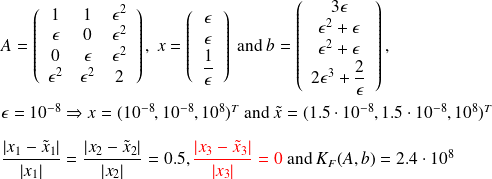Partial LLSP
Motivation
Consider the linear least-squares problem

 measures the sensitivity of the computed solution
measures the sensitivity of the computed solution
 to perturbations of the data
to perturbations of the data
 and
and
 .
.

We have from [Gratton 96]

Motivation
Consider the example
parameter estimation

Are some
 more sensitive than others to perturbations of the data ?
more sensitive than others to perturbations of the data ?
More generally if

What is the sensitivity of
 to perturbations of
to perturbations of
 and/or
and/or

Example : Exemple 1

If
 is a projection onto
is a projection onto
 or
or
 ,
,
 does not provide reliable information about the sensitivity of
does not provide reliable information about the sensitivity of
 .
.
Example :
Consider
 depend. on
depend. on

Approximate with a 3 deg. polynomial such that
Assume perturbations on
 of order
of order
 . For
. For
 computed solutions
computed solutions
 and
and
 , we obtain
, we obtain
whereas

Partial condition number
Definition : Condition number
Let

Since
 is
is
 -differentiable, we have
-differentiable, we have

we consider

Exact formula in Frobenius norm
Fundamental : Theorem 1
Let
 the thin singular value decomposition of
the thin singular value decomposition of
 with
with
 and
and
 . Then
. Then
 where
where
 is the diagonal matrix with
is the diagonal matrix with


Interpretation

 is large when there exist large
is large when there exist large
 and there exist
and there exist
 such that
such that

is large when
 has small singular values and
has small singular values and
 has components in the corresponding right singular vectors.
has components in the corresponding right singular vectors.

Particular case
If
 is a vector (
is a vector (
 ), then
), then

Remark: If we have the
 factor of the
factor of the
 decomposition of
decomposition of
 then
then


Bounds in spectral and Frobenius norm
Fundamental : Theorem
The absolute condition numbers of
 in the Frobenius and spectral norms can be respectively bounded as follows
in the Frobenius and spectral norms can be respectively bounded as follows

Proof
First note that we have

We start by establishing the lower bounds. Let
 and
and
 (resp.
(resp.
 and
and
 $) be right (resp. the left) singular vectors corresponding to the largest singular values of respectively
$) be right (resp. the left) singular vectors corresponding to the largest singular values of respectively
 and
and
 . We use a particular perturbation
. We use a particular perturbation
 expressed as
expressed as
 , where
, where

By replacing this value of
 in
in
 we get
we get
 .
.
Since
 we have
we have
 . Moreover we have
. Moreover we have
 and thus
and thus
 and can be written
and can be written
 for some
for some
 . Then
. Then
 .
.
It follows that

From
 and
and
 , we obtain
, we obtain
 .
.
Since
 and
and
 are unit vectors,
are unit vectors,
 can be be developed as
can be be developed as

By choosing
 the third term of the above expression becomes positive. Furthermore we have
the third term of the above expression becomes positive. Furthermore we have
 .
.
Then we obtain
 i.e
i.e
 .On the other hand, we have
.On the other hand, we have

Then
 and thus
and thus

So we have shown that
 for a particular value of
for a particular value of
 .
.
This proves that
 and
and
 .
.
Let us now establish the upper bound for
 . If
. If
 and
and
 , then it comes that
, then it comes that


where

and
 .
.
Hence

with
 .
.
Then, since
 , we have
, we have
 and(
and(
 ) yields
) yields
 which implies that
which implies that
 or
or
 .
.
An upper bound of
 can be computed in a similar manner : form the derivative of
can be computed in a similar manner : form the derivative of
 ,
,

where
 and
and
 .
.
Since
 we have
we have
 .
.
Using then the inequality
 we show that
we show that
 and obtain
and obtain
 which concludes the proof.
which concludes the proof.
Theorem (31)shows that
 can be considered as a very sharp estimate of the partial condition number expressed either in Frobenius or spectral norm. Indeed, it lies within a factor
can be considered as a very sharp estimate of the partial condition number expressed either in Frobenius or spectral norm. Indeed, it lies within a factor
 of
of
 or
or
 .
.
Another observation is that we have
 . Thus even if the Frobenius and spectral norms of a given matrix can be very different (
. Thus even if the Frobenius and spectral norms of a given matrix can be very different (
 ), the condition numbers expressed in both norms are of same order.
), the condition numbers expressed in both norms are of same order.
It results that a good estimate of
 is also a good estimate of
is also a good estimate of
 . Moreover if the R factor of
. Moreover if the R factor of
 is available,
is available,
 can be computed by solving two
can be computed by solving two
 by
by
 triangular systems with
triangular systems with
 right-hand sides and thus the computational cost is
right-hand sides and thus the computational cost is
 .
.
Bounds
In the general case where
 , then
, then
where


Remark
We show that
 .
.
we have

and






